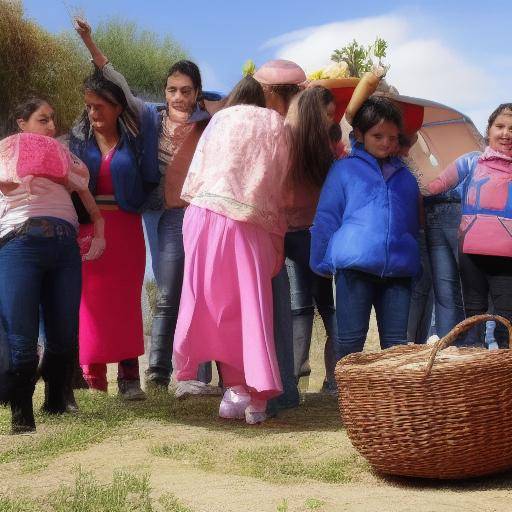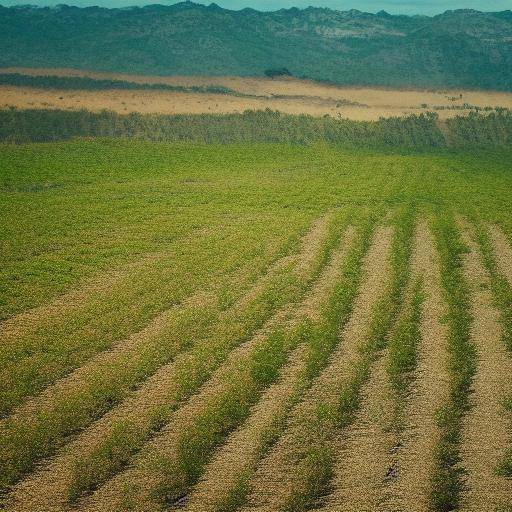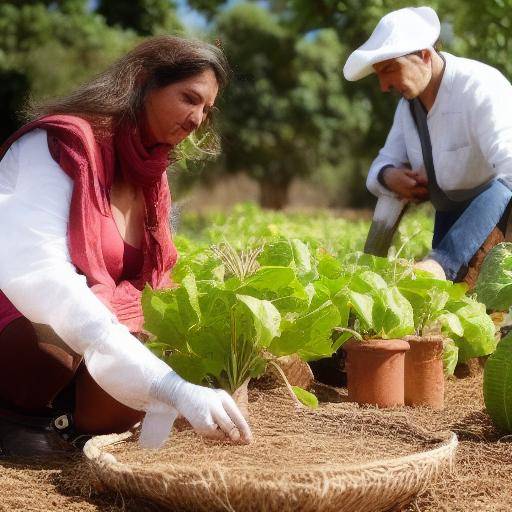
The link between fertility rites and agriculture has been a fundamental part of various cultures throughout history. Since ancient times, human societies have sought to understand and promote the fertility of the land and its crops through rituals and ceremonies. The connection between soil fertility and ritual practices is a subject of great relevance, both culturally and agriculturally. In this article, we will explore the relationship between fertility rites and agriculture, as well as their evolution over time, their impact on society, and current trends. We will also address the modern applicability of fertility rites in the agricultural context, providing a comprehensive and up-to-date view of this fascinating issue.
Agriculture: Foundation of Life and Society
Agriculture, the cornerstone of human civilization, is much more than just economic activity. It is a way of life, a cultural expression, and a means of ensuring the livelihood of societies. Since the beginning of humanity, agriculture has been the basis on which communities have developed, allowing food production, the development of local economies and the formation of complex social systems. The evolution of agricultural practices has generated a significant impact on the structure of society and the worldview of cultures throughout history.
At present, agriculture not only faces challenges related to sustainable food production and environmental protection, but also to the preservation of ancestral traditions and knowledge associated with land and its natural cycles.
Fertility Rites: Cultural Heritage and Nature Connection
Fertility rites, rooted in the beliefs and traditions of different cultures around the world, represent an ancestral attempt to understand and manipulate natural processes to ensure the prosperity of land and the abundance of crops. These rituals, often characterized by dances, songs and offerings, focus on invoking the fertility of the earth through symbolic practices and spiritual ceremonies.
Throughout history, fertility rites have been fundamental in the agricultural life of various societies, serving as a bridge between material and spiritual, human and divine.
Relationship between Fertility and Agriculture Rites
The connection between fertility rites and agriculture transcends the merely spiritual or symbolic: it is rooted in empirical observation of natural cycles and their influence in food production. Farmers have developed ritual practices based on knowledge and experience, seeking to intermediate with supernatural forces to ensure an abundant harvest and lasting soil fertility. Agricultural folklore and rituals associated with it have been important links in rural cultures, keeping alive traditions that often go back to ancient times.
The impact of these rituals lies not only in their influence on socio-cultural aspects, but also in how they shape the practical techniques and approaches of agriculture itself. The relationship between fertility rites and agriculture is therefore a fertile field for the understanding of the interaction between humanity and nature, as well as for the study of the influence of the spiritual in agricultural practices.
History and Background
Fertility rites have a millennial origin and are rooted in multiple cultures over time. The ancient Egyptians performed ceremonies in honor of the goddess Isis, considered the mother of fertility. Likewise, in ancient Greece, rituals were held to honor Deméter, the goddess of fertility and harvests. In Asia, the worship of the goddess of fertility, known with different names according to the regions, was also a fundamental part of agricultural life. These rituals were not only limited to religious practices, but included a range of agricultural knowledge and techniques associated with natural cycles and land-care.
Detailed Analysis
The analysis of fertility rites from a historical and cultural perspective reveals the deep connection between spirituality and agriculture. Over the centuries, these practices have permeated the daily lives of agricultural communities, influencing not only the way in which the work of the countryside is carried out, but also the cosmovision and sense of belonging to the earth.
At present, the detailed study of fertility rites allows us to understand its relevance in the context of modern agriculture and its potential to strengthen the resilience of agricultural systems in the face of current challenges. Ancient knowledge associated with natural cycles and land fertility continues to provide valuable insights that can be applied to foster sustainability and productivity in agriculture.
Comprehensive review
In considering the benefits and challenges of integrating fertility rites into contemporary agricultural practices, it is crucial to take into account the complexity of this interaction. While traditional knowledge can offer innovative and sustainable solutions for agriculture, it is also necessary to address the potential obstacles and constraints that may arise in trying to apply these practices in the modern context.
The incorporation of fertility rites into current agriculture requires a balanced approach that recognizes the importance of preserving ancestral traditions and knowledge, while seeking to integrate them with contemporary agricultural technologies and practices.
Comparative analysis
By comparing the relationship between fertility rites and agriculture in different cultural contexts, it is possible to identify significant similarities and differences in the way these practices have evolved and adapted over time. While in some communities, fertility rites have maintained their relevance continuously, in others they have experienced significant changes or have even fallen into disuse.
Exploring these variations provides a wider understanding of cultural diversity and the impact that fertility rites have had on agricultural practices in different parts of the world. In addition, it allows to identify useful lessons and perspectives that can be effectively applied in contemporary agriculture.
Practical Tips and Accessible Recommendations
The integration of fertility rites in modern agriculture can be a challenging but highly enriching process. In considering how these practices can be adapted and applied in a current context, it is crucial to involve relevant actors, including farmers, researchers, community leaders and local authorities.
Some practical recommendations include:
- Documentation and preservation of traditional fertility rituals and ceremonies.
- Promote collaboration between agricultural communities and agricultural sustainability experts.
- Integrate ancestral knowledge with modern technologies to promote soil conservation and crop diversity.
Industry Visions and Expert Reviews
The vision of experts and leaders of the agricultural industry provides a valuable perspective on the role of fertility rites in the current context. The feedback of agronomists, anthropologists, and innovative farmers contributes to a more comprehensive understanding of how these practices can be effectively applied in contemporary agricultural environments.
Experts emphasize that while fertility rites can be seen as a spiritual manifestation, it is crucial to recognize their intrinsic connection with the fundamental principles of agriculture and the sustainable management of natural resources. The integration of ancestral knowledge with modern technologies is presented as an opportunity to develop more environmentally friendly and resilient agricultural approaches.
Case Studies and Practical Applications
Case studies and practical applications provide concrete examples of how fertility rites have been incorporated into contemporary agriculture. From soil conservation projects to agroecology initiatives, these examples illustrate the relevance and potential of these practices in the implementation of sustainable agricultural systems.
In studying these cases, it is possible to identify patterns and lessons that can be applied in different agricultural contexts, contributing to a more holistic understanding of the benefits and challenges associated with integrating fertility rites into modern agriculture.
Future Trends and Predictions
The analysis of future trends in agriculture and fertility rites provides a proactive perspective on the potential impact of these practices in the future. With increased attention to sustainability and biodiversity conservation, knowledge and practices associated with fertility rites are expected to become more relevant in the development of innovative and sustainable agricultural approaches.
Predictions suggest that the integration of fertility rites into contemporary agriculture will not only contribute to the conservation of cultural heritage, but will also play a crucial role in promoting the resilience and sustainability of global food systems.
Conclusion
In conclusion, the relationship between fertility rites and agriculture is a broad and complex field covering cultural, historical, practical and spiritual aspects. Recognition of the importance of these practices in modern agriculture is crucial to fostering more integrated, sustainable and respectful agricultural approaches with nature.
In exploring this relationship from a holistic approach, it is possible to identify opportunities to strengthen the resilience of agricultural systems, preserve cultural diversity and promote the conservation of natural resources. The integration of ancestral knowledge associated with fertility rites with modern technologies offers a promising path to building more equitable, healthy and sustainable food systems for present and future generations.
Frequently asked questions
What is the importance of fertility rites in modern agriculture?
Fertility rites have a significant relevance in modern agriculture, as they represent an invaluable source of sustainable knowledge and practices for land care and the promotion of agricultural productivity. Moreover, the preservation of these rituals contributes to the preservation of the cultural and spiritual heritage associated with agriculture.
What are the main challenges to integrating fertility rites into contemporary agriculture?
One of the main challenges for the integration of fertility rites in contemporary agriculture is the need to adapt these practices to modern agricultural contexts, considering the demands of commercial production and the application of sustainable technologies. Moreover, it is important to address the preservation of the authenticity and cultural significance of these rituals in an increasingly globalized world.
How can modern farmers benefit from fertility rites?
Modern farmers can benefit from fertility rites by integrating traditional knowledge on land management, agricultural timetable and nature conservation practices. These ancestral lessons can complement and even improve current agricultural practices, contributing to the environmental sustainability and resilience of food production systems.
What is the impact of fertility rites on the resilience of agricultural systems?
The impact of fertility rites on the resilience of agricultural systems lies in their potential to promote soil conservation, sustainable use of natural resources and adaptation to environmental challenges. By incorporating traditional fertility and land management practices, farmers can strengthen the capacity of their agricultural systems to deal with adverse climate phenomena and maintain long-term productivity.
What are some ways to preserve fertility rites in contemporary agriculture?
The preservation of fertility rites in contemporary agriculture can be achieved through actions such as the documentation of ritual practices, the promotion of cultural activities linked to agriculture, and the intergenerational transmission of traditional knowledge. In addition, recognition and appreciation of the importance of these practices by agricultural institutions and policies is essential for their long-term preservation.
What role do fertility rites play in the conservation of crop diversity?
Fertility rites play a crucial role in the conservation of crop diversity by promoting the preservation of local varieties and the promulgation of traditional farming practices. By maintaining agricultural biodiversity and protecting knowledge associated with agricultural practices, these rituals contribute to the conservation of plant species and global food security.
How can fertility rites contribute to the promotion of sustainable agricultural practices?
Fertility rites can contribute to the promotion of sustainable agricultural practices by providing lessons on integrated management of agricultural systems, the protection of natural resources and the promotion of harmony between human activities and the natural environment. By integrating these ancestral knowledge, farmers can implement more equitable and sustainable approaches to food production.
Final considerations
In the intersection between fertility rites and modern agriculture, there is a unique opportunity to merge ancestral wisdom with contemporary demands. The integration of fertility rites into agriculture not only involves agronomic aspects, but also fuels the spiritual need to connect with the earth and honor the natural cycles that sustain life.
Keeping these ancestral practices alive not only represents a tribute to cultural diversity, but also offers a way towards building more resilient and sustainable agricultural systems. From the preservation of biodiversity to the promotion of social justice in food production, fertility rites can serve as pillars for a more equitable, healthy and harmonious agriculture with nature.













